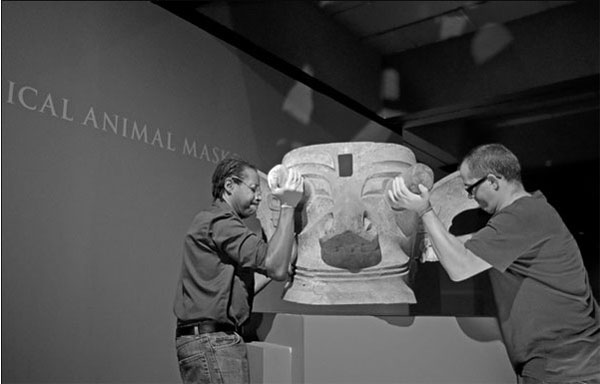 |
|
Workers at the Bowers Museum set up the bronze Mask with Protruding Eyes, in Santa Ana, California, for the exhibition China's Lost Civilization: The Mystery of Sanxingdui. [Photo/Agencies] |
For whatever reason these objects were made and then discarded, they themselves are moving now, just as their creators did three millennia ago. The artifacts were on display on Sunday at southern California's Bowers Museum, the first stop on a rare tour of the United States.
China's Lost Civilization: The Mystery of Sanxingdui includes more than 100 ancient pieces, some never seen outside China. The exhibit will remain at the Bowers until March 15, after which they will move to Houston's Museum of Natural Science.
"You look at these figures and they're really unworldly," says the museum's president, Peter Keller, as he stands in the shadow of an 2.4-meter-tall statue of a man in bare feet, flowing robe and an elaborate headdress.
Keller was waiting inside the museum for workers to uncrate a 57-kg companion piece - a floppy-eared, bug-eyed bronze "mask" about the size of a sofa.
"China is full of mysteries, but to me this is China's greatest mystery,"' Keller continues as he gazes at the mask that contained a smile as enigmatic as the Mona Lisa's. "Who were these people and where did they go?"
That's a mystery that's been bugging archaeologists since Chinese bricklayers stumbled across the treasures in 1986, said Suzanne Cahill, an authority on ancient Chinese civilizations and the exhibition's curator.
"Wow, 1200 BC people are doing stuff like that and we think we're so technically evolved," she says. "It's kind of humbling, actually."
Although there is evidence of bronze works at the time in China's Central Plain, some 1,200 kilometers away, none come close to being this elaborate.
The Chinese first discovered they were on to something special in 1926, when a farmer uncovered a few relics in Sanxingdui, on the outskirts of Sichuan province's capital city of Chengdu.
But it wasn't until 1986 that the country was awed by a find the Chinese would label one of the great wonders of the world.
That was when workers began pulling the gigantic head, now named Mask with Protruding Eyes, out of the ground, along with the really tall guy who has since been nicknamed Standing Figure.
Fifteen years later, more relics were found in another pit, some 40 km away in Jinsha. Scholars suspect they were made by the same people, who also mysteriously abandoned that area.
Little has subsequently been learned about these people, other than they abruptly vanished about 350 years after making the bronzes. "They certainly don't look Chinese," Cahill says of the bronze images of people. "They barely even look human."
That, she adds, has led some people to say, "Oh, my gosh, they must have been made by aliens."
She doubts that, noting that the tall statute has a pair of hands that appear to have been shaped specifically to hold one of the 80 elephant tusks found buried with it. More likely it was modeled after a nobleman, she believes, or was created as a deity.
But then there's the question of how the Asian elephants whose tusks were found in the pit got there.
Elephants at the time were thought to be a thousand or so miles away in Vietnam or the far reaches of Southwest China. The find indicates the Sanxingdui people may have lived on a heretofore unknown trade route.
|
|
|
|
|
|
|
|
